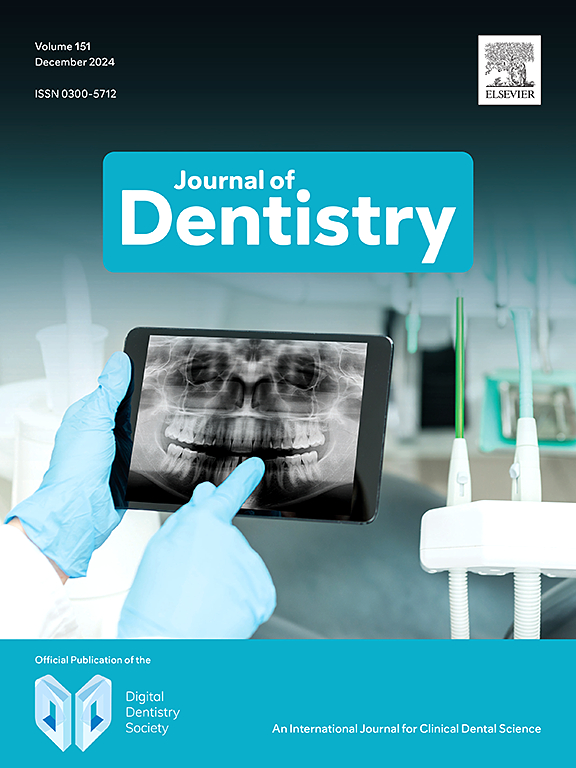动态导航引导下的机器人颧骨植入术
IF 4.8
2区 医学
Q1 DENTISTRY, ORAL SURGERY & MEDICINE
引用次数: 0
摘要
目的:评估新型机器人种植系统在无牙颌模型中植入颧骨种植体的可行性和准确性:评估在无牙上颌模型中植入颧骨种植体的新型机器人种植系统原型的可行性和准确性:研究在八个塑料模型上进行。对每个模型进行锥形束计算机断层扫描,以规划颧骨种植体的位置。使用手眼校准技术将动态导航系统注册到机器人空间。总共植入了 16 个颧骨植入体,平均分布在颧骨的前部和后部。种植体(ZYGAN®,Southern Implants)的植入是在动态导航坐标变换矩阵的引导下,使用主动六关节机器人手臂(UR3e,Universal Robots)完成的。根据术前和术后的 CBCT 叠加结果,使用 EvaluNav 和 GeoMagicDesignX® 软件对种植体植入的准确性进行了评估。对种植体偏差进行了描述性统计,并对这些偏差与机械臂记录的力反馈进行了皮尔逊相关分析:结果:入口点和出口点的三维偏差分别为 1.80 ± 0.96 毫米和 2.80 ± 0.95 毫米。角度偏差为 1.74 ± 0.92°。模型每侧的整体配准时间为 23.8 ± 7.0 分钟。每条轨迹的手术时间(不包括配准时间)为 66.8 ± 8.8 分钟。种植体的出口点和角度偏差与垂直于手机长轴的钻孔力呈正相关,而与平行于手机长轴的钻孔力呈负相关:结论:动态导航引导机器人植入颧骨种植体的误差在临床可接受范围内。临床意义:临床意义:无论操作者的手术经验或疲劳程度如何,机器人植入颧骨种植体都有可能产生高度可预测的结果。本研究为临床应用铺平了道路。本文章由计算机程序翻译,如有差异,请以英文原文为准。
Dynamic navigation-guided robotic placement of zygomatic implants
Objectives
To assess the feasibility and accuracy of a new prototype robotic implant system for the placement of zygomatic implants in edentulous maxillary models.
Methods
The study was carried out on eight plastic models. Cone beam computed tomographs were captured for each model to plan the positions of zygomatic implants. The hand-eye calibration technique was used to register the dynamic navigation system to the robotic spaces. A total of 16 zygomatic implants were placed, equally distributed between the anterior and the posterior parts of the zygoma. The placement of the implants (ZYGAN®, Southern Implants) was carried out using an active six-jointed robotic arm (UR3e, Universal Robots) guided by the dynamic navigation coordinate transformation matrix. The accuracy of the implant placement was assessed using EvaluNav and GeoMagicDesignX® software based on pre- and post-operative CBCT superimposition. Descriptive statistics for the implant deviations and Pearson's correlation analysis of these deviations to force feedback recorded by the robotic arm were conducted.
Results
The 3D deviations at the entry and exit points were 1.80 ± 0.96 mm and 2.80 ± 0.95 mm, respectively. The angular deviation was 1.74 ± 0.92°. The overall registration time was 23.8 ± 7.0 min for each side of the model. Operative time excluding registration was 66.8 ± 8.8 min for each trajectory.
The exit point and angular deviations of the implants were positively correlated with the drilling force perpendicular to the long axis of the handpiece and negatively correlated with the drilling force parallel to the long axis of the handpiece.
Conclusion
The errors of the dynamic navigation-guided robotic placement of zygomatic implants were within the clinically acceptable limits. Further refinements are required to facilitate the clinical application of the tested integrated robotic-dynamic navigation system.
Clinical significance
Robotic placement of zygomatic implants has the potential to produce a highly predictable outcome irrespective of the operator's surgical experience or fatigue. The presented study paves the way for clinical applications.
求助全文
通过发布文献求助,成功后即可免费获取论文全文。
去求助
来源期刊

Journal of dentistry
医学-牙科与口腔外科
CiteScore
7.30
自引率
11.40%
发文量
349
审稿时长
35 days
期刊介绍:
The Journal of Dentistry has an open access mirror journal The Journal of Dentistry: X, sharing the same aims and scope, editorial team, submission system and rigorous peer review.
The Journal of Dentistry is the leading international dental journal within the field of Restorative Dentistry. Placing an emphasis on publishing novel and high-quality research papers, the Journal aims to influence the practice of dentistry at clinician, research, industry and policy-maker level on an international basis.
Topics covered include the management of dental disease, periodontology, endodontology, operative dentistry, fixed and removable prosthodontics, dental biomaterials science, long-term clinical trials including epidemiology and oral health, technology transfer of new scientific instrumentation or procedures, as well as clinically relevant oral biology and translational research.
The Journal of Dentistry will publish original scientific research papers including short communications. It is also interested in publishing review articles and leaders in themed areas which will be linked to new scientific research. Conference proceedings are also welcome and expressions of interest should be communicated to the Editor.
 求助内容:
求助内容: 应助结果提醒方式:
应助结果提醒方式:


